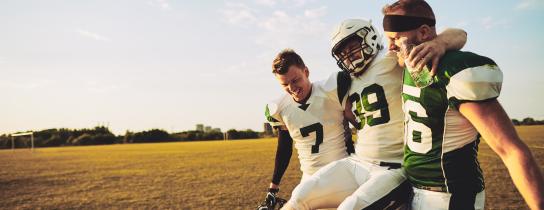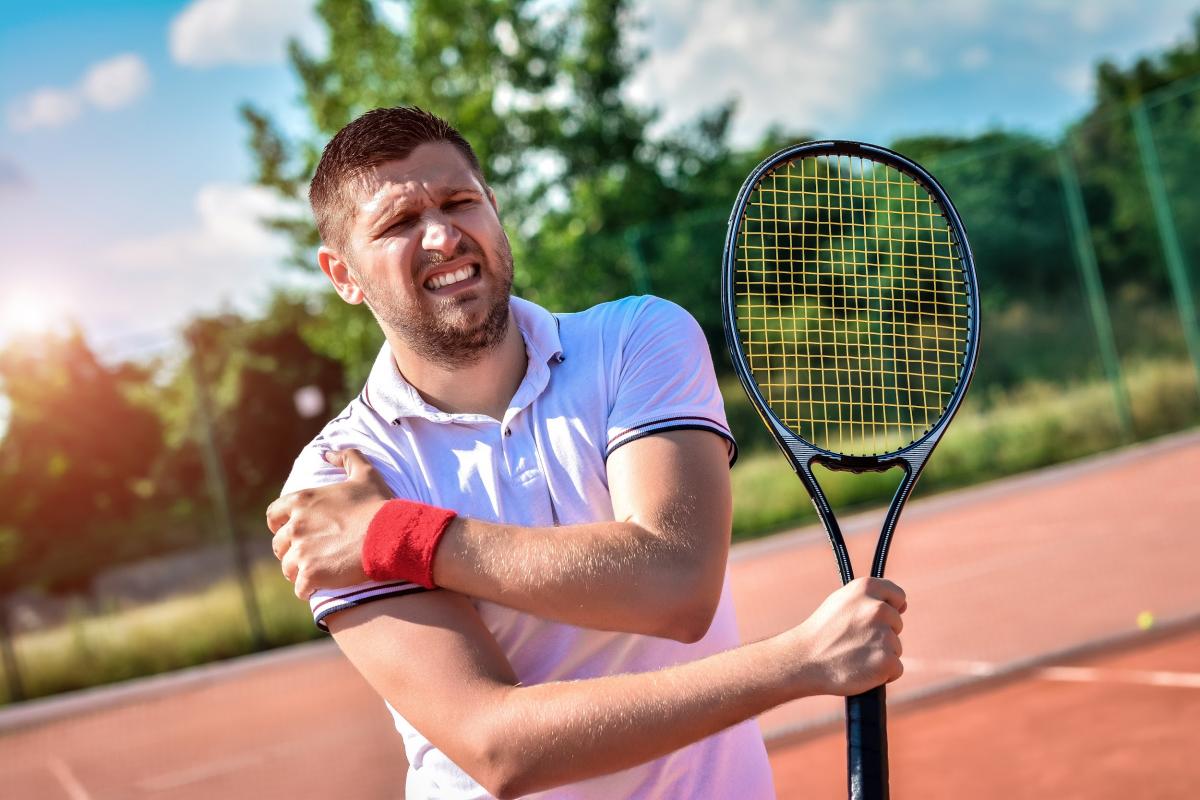
6 Kinds of Sports Injuries and How They’re Treated
In any sport, there is some risk of injury. Here are 6 common sports injuries, how they happen, and how they’re typically treated.
Sprains
A sprain is an injury that occurs when a ligament is overstretched or begins to tear. Ankle sprains are the most common, but they also often occur in the wrists and knees. Common symptoms of sprain include swelling, pain, bruising, loss of mobility, and joint instability.
How Sprains Happen
Sprains typically happen as a result of falling, taking an impact, or otherwise overstretching the joint. Rolling the ankle while running, landing, or stepping on uneven terrain is a very common example. In contact sports, anything that redirects the body or causes weight to shift can lead to a fall or roll.
How Sprains Are Treated
Mild to moderate sprains are typically treated with the RICE method:
- Rest the joint (abstain from the sport while the sprain heals).
- Ice the area of the sprain to reduce swelling and pain.
- Compress the area with a compression garment or wrap.
- Elevate the injured body part above the heart.
Over-the-counter pain relievers like aspirin and ibuprofen are commonly recommended for pain. In most cases, the person can begin gently using the strained joint in a few days. Surgery may be necessary in some cases.
Torn Ligaments

A torn ligament is technically a more severe type of sprain. In sports, some of the most commonly torn ligaments include the ACL (anterior cruciate ligament), MCL (medial collateral ligament), and PCL (posterior cruciate ligament) of the knee. Other common locations include the ankles and wrists. Symptoms of torn ligaments include severe pain, a popping/snapping sound during injury, swelling, and joint instability.
How Torn Ligaments Happen
A standard sprain may have some tearing, but a significantly torn ligament results from a much greater force. The impact and weight of a football tackle, for example, could cause a ligament to tear. A hard fall that bends a body part to an extreme degree is another possible cause.
How Torn Ligaments Are Treated
The treatment for a torn ligament varies by how severe the tear is. The initial protocol for a ligament injury is the RICE (rest, icing, compression, elevation) method. Over-the-counter pain relievers may be used.
If it is a significant partial tear, a brace may be necessary to keep the joint immobilized during healing. If it is a complete tear, the ligament will require surgery. This will likely be followed by physical therapy, and healing may take weeks to months.
Dislocations
A dislocation is an injury in which the bones of a joint are moved out of their normal position. Dislocations often occur in shoulders and hands, but can also affect the knees, hips, elbows, and other joints. A dislocated joint is painful, looks deformed, and cannot move normally. There may also be swelling or bruising.
How Dislocations Happen
Dislocations commonly occur in high-impact sports like football, hockey, basketball, or gymnastics. When an athlete takes a hard fall, collides with someone, or has heavy pressure placed on a joint, the bone can be forcefully pushed out of the joint socket.
How Dislocations Are Treated
Dislocations require immediate medical attention. While waiting for medical care, the joint area should be immobilized and iced. After examining and taking images of the injury, a doctor may try to reset the joint by gently manipulating the parts. If they can’t be repositioned that way, they may do so surgically.
Pain may be addressed with anesthetics, over-the-counter pain relievers, and prescription medications. After the joint is corrected, the patient may need to wear a sling or splint for several weeks while it heals.
Ruptured Tendons

A ruptured tendon occurs when the tissue connecting muscle to bone partially or completely tears. Common locations for ruptures include the Achilles tendon, quadriceps, biceps, and rotator cuff. Signs of tendon rupture include severe pain, swelling, a snapping/popping sound during injury, bruising, inability to use or bear weight on the area, weakness, and physical deformity.
How Ruptured Tendons Happen
Trauma from impact, overstretching, falling, or straining can cause a ruptured tendon. In sports, over-flexing a joint or twisting a body part is a common means of tearing. For example, the Achilles tendon at the back of the ankle may rupture if the foot is forced into an extreme flex. Age is another risk factor, as blood supply to the tendons decreases over time.
How Ruptured Tendons Are Treated
A tendon rupture should receive medical attention right away, but the standard RICE method (rest, icing, compression, and elevation) is recommended in the meantime. A partial tear may be treatable without surgery, but a complete tear will require surgical reconstruction.
The injured part is immobilized during healing, which can take several weeks. Immobilization varies depending on the location of the rupture. For a bicep rupture, the arm is placed in a sling in a bent position. For a quadricep rupture, the leg is immobilized in a straight position.
Concussions
A concussion is a type of traumatic brain injury that occurs when force causes the brain to impact against the skull. Concussions are usually not life-threatening, but they can have lasting effects on cognitive abilities.
Symptoms include dizziness, confusion, vision problems, drowsiness, headaches, nausea, balance problems, and a feeling that you’re not thinking clearly. Some individuals lose consciousness with concussions, but not all do.
How Concussions Happen
Concussions are most common in contact sports like football, in which players regularly take impacts from falls, tackles, and hits from other players. However, they can occur in a variety of sports. An athlete could also suffer a concussion after falling from a balance beam or being hit with a ball.
How Concussions Are Treated
In cases with severe symptoms, there may be bleeding or damage to the brain that needs to be addressed with surgery. However, most concussions are relatively mild and can be treated with rest and over-the-counter pain relievers.
Depending on the severity of the concussion, a doctor may recommend abstaining from sports, driving, and other activities for a few days to a few months. If symptoms worsen or don’t improve, further treatment might be necessary.
Fractures
A fracture is the breakage of bone. There are several types of fractures, including compound fracture (exposed bone) and stress fracture (small cracks in the bone). Symptoms may include pain, tenderness, swelling, bruising, deformity, or even visible bone.
How Fractures Happen
In sports, fractures may occur as a result of a fall, impact, overuse, or other stress. A hockey player, for example, may suffer a fracture if they are checked too hard by another player. Using poor technique in a sport is another factor that can stress bones and increase fracture risk. Some athletes may be more susceptible to fractures than others, depending on their anatomy and bone health.
How Fractures Are Treated
Fractures should be immediately seen by a medical professional, who will start by taking x-rays to see the full extent of the injury. Doctors will then do their best to place the bone(s) back in their original position, either with or without surgery.
Once the bones are correctly arranged, the injured part is immobilized to keep them in place. This may be done with a cast, splint, external fixators, internal plates, and screws or a combination of methods. Depending on the injury, recovery can take a few weeks to several months.
Find Treatment for Sports Injuries at Crystal Run Healthcare
Crystal Run Healthcare is a trusted New York provider of healthcare services across a variety of specialties. Make an appointment with one of our sports medicine doctors or call (845) 703-6999 to learn more about how we can help you stay healthy.

 Optum Radiology at Crystal Run Healthcare
Optum Radiology at Crystal Run Healthcare Request medical records online
Request medical records online